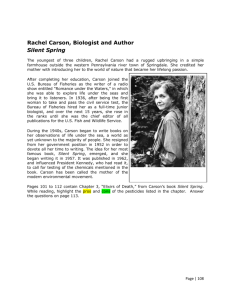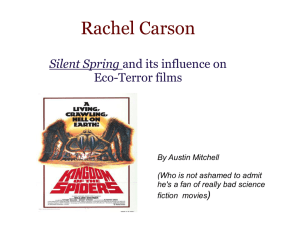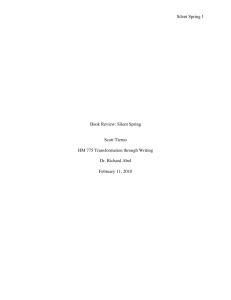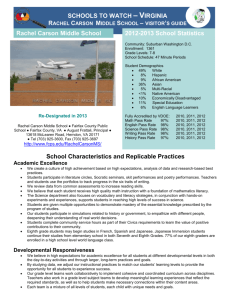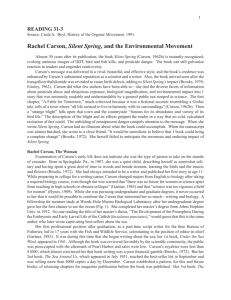Silent Spring Lesson Plan: Environmental Science & Literature
advertisement
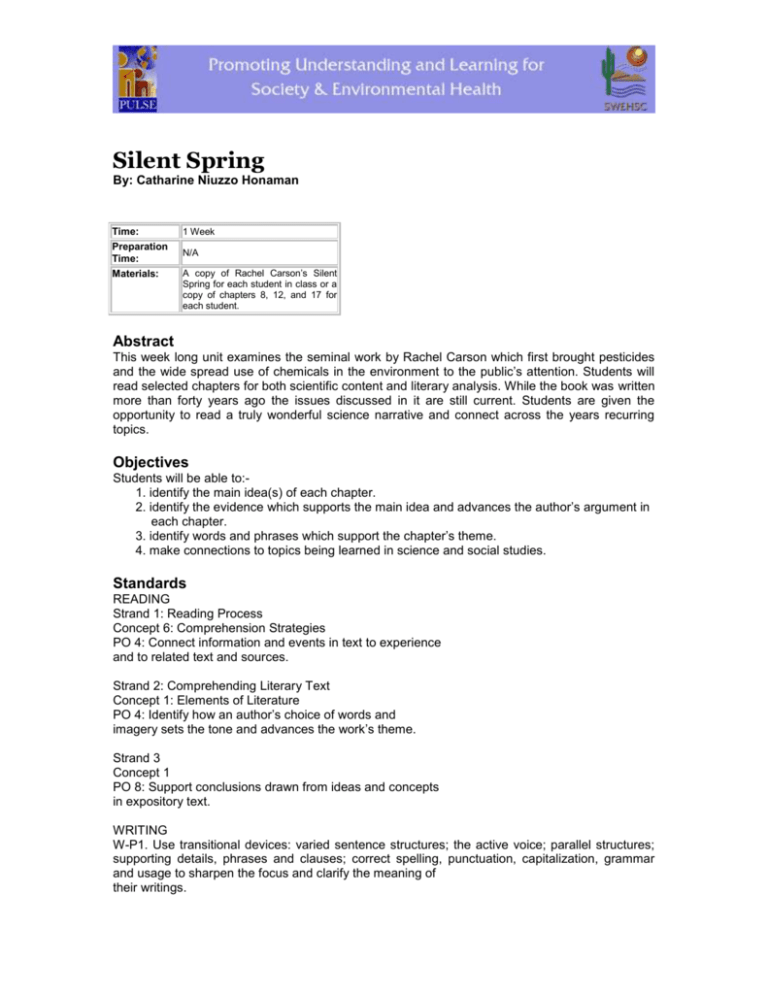
Silent Spring By: Catharine Niuzzo Honaman Time: 1 Week Preparation Time: N/A Materials: A copy of Rachel Carson’s Silent Spring for each student in class or a copy of chapters 8, 12, and 17 for each student. Abstract This week long unit examines the seminal work by Rachel Carson which first brought pesticides and the wide spread use of chemicals in the environment to the public’s attention. Students will read selected chapters for both scientific content and literary analysis. While the book was written more than forty years ago the issues discussed in it are still current. Students are given the opportunity to read a truly wonderful science narrative and connect across the years recurring topics. Objectives Students will be able to:1. identify the main idea(s) of each chapter. 2. identify the evidence which supports the main idea and advances the author’s argument in each chapter. 3. identify words and phrases which support the chapter’s theme. 4. make connections to topics being learned in science and social studies. Standards READING Strand 1: Reading Process Concept 6: Comprehension Strategies PO 4: Connect information and events in text to experience and to related text and sources. Strand 2: Comprehending Literary Text Concept 1: Elements of Literature PO 4: Identify how an author’s choice of words and imagery sets the tone and advances the work’s theme. Strand 3 Concept 1 PO 8: Support conclusions drawn from ideas and concepts in expository text. WRITING W-P1. Use transitional devices: varied sentence structures; the active voice; parallel structures; supporting details, phrases and clauses; correct spelling, punctuation, capitalization, grammar and usage to sharpen the focus and clarify the meaning of their writings. Resource Websites http://www.lkwdpl.org/wihohio/cars-rac.htm http://www.rachelcarson.org/index.cfm?fuseaction=bio http://rachelcarson.fws.gov/carsonbio.html Activity Engage 1. Scientific writing is sometimes characterized as dry and overly technical. Perhaps for that reason, people often shy away from reading books and articles based on science topics. One blaring exception is science fiction. But can the students think of other written or visual media that are science based which people read or watch for fun? Some examples the students may come up with are: National Geographic (magazine and television show), Scientific American, Popular Science, Nova, The Discovery Channel, etc. Another example of great writing that contains accurate scientific information conveyed through moving prose is Rachel Carson’s seminal work Silent Spring. 2. Go through the table of contents of Silent Spring with the students. Have them imagine what a short story, poem, painting (or other work of art), or even a scientific article might be about for some (or if time permits, all) of the chapter titles: 1) A Fable for Tomorrow 2) The Obligation to Endure 3) Elixirs of Death 4) Surface Waters and Underground Seas 5) Realms of the Soil 6) Earth’s Green Mantle 7) Needless Havoc 8) And No Birds Sing 9) Rivers of Death 10) Indiscriminately from the Skies 11) Beyond the Dreams of the Borgias 12) The Human Price 13) Through a Narrow Window 14) One in Every Hour 15) Nature Fights Back 16) The Rumblings of an Avalanche 17) The Other Road 3. Give the students time to write down their answers. Then they can share their ideas in a class discussion or they can get into small groups to compare their musings. 4. Give the students some background information about Rachel Carson. A few helpful websites are: http://www.lkwdpl.org/wihohio/cars-rac.htm http://www.rachelcarson.org/index.cfm?fuseaction=bio http://rachelcarson.fws.gov/carsonbio.html 5. From her biography the students can see that Rachel Carson wrote passionately and accurately about environmental issues. Knowing this they should read chapters 8: “And No Birds Sing,” 12:”The Human Price,” and 17: “The Other Road.” Depending on how much homework is appropriate for your student population, you may wish to either have the students read the chapters as part of their classroom activities or as an outside assignment. Suggested activities for the chapters are: #8: “And No Birds Sing” 1) What is the main idea of this chapter? 2) List the evidence used to support the main idea. 3) What connections can be made to concepts and information that you are learning in science and social studies? 4) Select a paragraph or a passage that is especially vibrant and expressive. Which words and phrases in that passage evoke strong images and/or convey emotional content? 5) What part of the food web is described? #12: ”The Human Price” 1) What is the main idea of this chapter? 2) List the evidence used to support the main idea. 3) What connections can be made to concepts and information that you are learning in science and social studies? 4) Select a paragraph or a passage that is especially vibrant and expressive. Which words and phrases in that passage evoke strong images and/or convey emotional content? 5) What are some of the impacts on human health described? #17: “The Other Road” 1) What is the main idea of this chapter? 2) List the evidence used to support the main idea. 3) What connections can be made to concepts and information that you are learning in science and social studies? 4) Select a paragraph or a passage that is especially vibrant and expressive. Which words and phrases in that passage evoke strong images and/or convey emotional content? 5) Does the book end optimistically or pessimistically? Cite a passage to back up your opinion. 6) In chapter 17 many possible alternatives to spraying pesticides are proposed. Ask the students to research whether any of these alternative methods are actually being used. Where are they being employed? How successful are they? Are there methods not mentioned in the chapter that have become effective ways to battle various insect scourges? Can the students devise any methods that have not yet been invented or suggested? EXTENSIONS If time permits, more chapters in Silent Spring could be read. Chapters of Silent Spring 1. A Fable for Tomorrow 2. The Obligation to Endure3 Elixirs of Death 4. Surface Waters and Underground Seas5 Realms of the Soil 6. Earth’s Green Mantle7 Needless Havoc 8. And No Birds Sing9 Rivers of Death 10. Indiscriminately from the Skies 11. Beyond the Dreams of the Borgias12 The Human Price 13. Through a Narrow Window14 One in Every Hour 15. Nature Fights Back16 The Rumblings of an Avalanche 17. The Other Road Embedded Assessment Students should be evaluated on how well they were able to pick out the main idea of each chapter and the evidence supporting that idea. They should also be assessed on how well they were able to make connections between what they have been learning in science and social studies and the concepts and situations described in Silent Spring. Furthermore, students should be assessed on their ability to identify words and phrases which create strong imagery.
